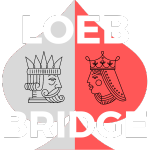When your opponents open the auction, you can compete with an overcall or a takeout double.
Your goals when competing are:Find your best strain and level
- Find your best contract and level
- Direct the lead
- Obstruct your opponents’ auction
- Find a profitable sacrifice
- Push the opponents too high
An overcall at the 1-level shows a 5+ card suit and 8-17 HCP. With 18+ HCP begin with a double and then bid your suit to show your strength. Overcalling a 4-card suit risks getting too high. If your partner has 4-card suit they are likely to compete to the 3-level based on the “Law of Total Tricks” which advises contracting for 9 tricks with a 9-card fit.
An overcall at the 2-level shows a 5+ card suit (ideally 6+), and 13-17 HCP.
With 18+ begin with a double and then bid your suit to show a big hand. Partner will expect your double to be a normal takeout double, but when you freely bid your suit, partner will know you have a hand too strong to overcall (a 5+ card suit and 18+ points).
An overcall should show a good suit and/or a good hand. An obstructive overcall merits some leeway. Similarly, you might make an exception for a 1♠ overcall because of the importance of getting the boss suit in play.
Terminology: On the auction below North is the Opener, East is the Intervenor, South is the Responder, and West is the Advancer.
|
North |
East |
South |
West |
|
1♦ |
1♥ |
1♠ |
? |
Advancing an Overcall (aka Responding to an Overcall)
Advancing an overcall is a complex subject, requiring partnership agreement. Some partnerships play a new suit by Advancer is forcing. Some require a jump in a new suit to force. For them, a minimum bid of a new suit is natural (4+ cards, usually 5+) and is non-forcing. This approach is popular because it helps you find the best strain after your partner's overcall. If a new suit is forcing, the advancer may not have the strength to introduce their suit. Playing a new suit as non-forcing allows the advancer to show their suit more often.
Advancer should raise partner with 3+ card support, especially if the overcall was in a major. Choose your raise based on your Support Points for partner’s overcalled suit. The table below shows how to raise partner’s 1♥ overcall in the above auction.
|
Bid |
Support |
Support Points |
Additional Information |
|
2♥ |
3+ |
6-10 |
Single raise |
|
3♥ or 4♥ |
4+ |
0-6 |
Weak raise |
|
2♦ (cue bid) |
3+ |
11+ |
Invitational or better |
Intermediate and advanced partnerships may want to add the following agreements when they are ready
|
Bid |
Support |
Support Points |
Additional Information |
|
2NT (over a major) |
4+ |
11+ |
Artificial, invitational or better |
|
3♦ (jump cue bid) |
4+ |
8-10 |
|
|
3♠, 4♣, or 4♦ |
4+ |
13+ |
Splinter Bid |
Sometimes a 2nd Game Try is Needed
A cue bid by advancer shows an invitational or better raise.
|
North |
East |
South |
West |
|
1♦ |
1♥ |
1♠ |
2♦ |
On the auction above, West cue bid of opener’s suit shows 3+ card support and 11+ Support Points. East will decline the invitation by bidding 2♥ if they have less than 14 points. If East has an opening hand, East should show their extra values by making another game try. If West has 12 or 13 points, West can now bid 4♥.
When advancer is planning to make a 2nd game try, they should begin with a cue bid, even with 4+ trump, to leave room for a 2nd game try.
After a minor suit overcall, an advance to 2NT should be natural.
|
North |
East |
South |
West |
|
1♦ |
2♣ |
Pass |
2NT |
Since 3NT is preferred over a minor suit game. A jump to 2NT should be natural and invitational, showing 12-14 points, and stoppers.
An exception would be a contested auction like the one below. Pairs playing Good-Bad 2NT use an artificial 2NT bid to differentiate competitive bid from invitational bids.
|
North |
East |
South |
West |
|
1♦ |
2♣ |
2♦ |
2NT |
See our Good-Bad 2NT article for more on this topic.
Related Articles
- "What are the main reasons for overcalling?" by Andrew Robson
- "SQOT:" - The Suit Quality Overcall Test by Andrew Robson
- "The Simple Overcall" by David Lindop
- "Overcalls - part 1" and "Overcalls - part 2" by the ACBL




